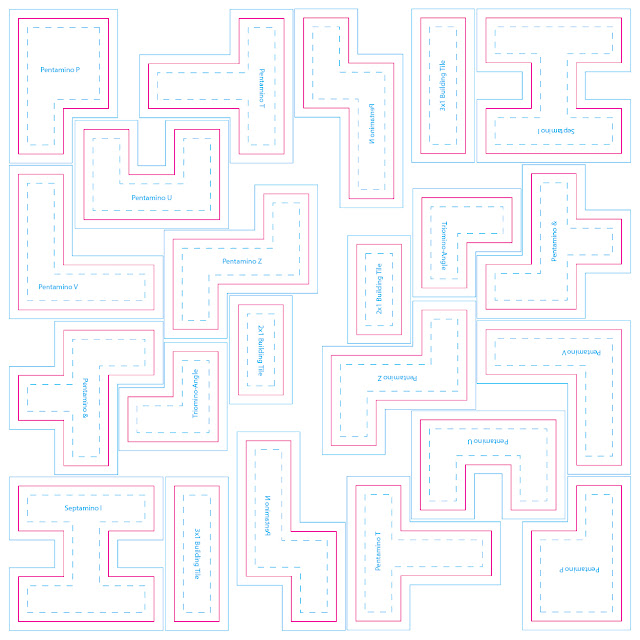Crystal Mandalas in Card Game Design
After describing the organic "wabi-sabi" style of card game design I used in Belle of the Ball, I got some comments on boardgamegeek expressing a preference for more symmetrical deck design.
Mark McEvoy : "I'm of the camp that prefers the symmetrical systematic approach because then you can be certain that specific combinations exist / are unique / are not disproportionately plentiful in your deck."
David Boeren : "If there is ever a time where the different elements interact with each other then I do not want them randomly assigned. That makes it harder to balance and it makes it hard on the players who now have to remember a lot more about the deck to avoid bad play decisions."
Sure, I see the appeal. But speaking as a designer, it's way too easy to get sucked into a death-spiral of perfectly symmetrical mandalas. These precious crystal structures are such fastidious distractions for OCD perfectionists like me.
The example above is one way to divide up a 180-card deck. There are two halves (36 cards each; day, night), six elements (28 cards each; fire, electricity, plant, water, air, earth), and twelve individual groups (9 cards each; Group 1 – Group 12). Sixty cards have a combination of one half, one group and one element. Sixty cards have a combination of one half, one group and one element. Thirty-six cards have a combination of one half, one group and two elements. Twelve cards have a combination of one half, one group and three elements.
Oh, but wait! What about cards with four elements? Five elements? Could some cards straddle two or more groups? Is there a ranking system for the single-element cards? But crap, that would make more than 108 cards. Whatever shall we do? omg!
Yeah... See what I mean? This kind of meticulous deck composition is waaay too fussy. More time is spent organizing these compositions than actually designing a game. Sure is pretty to look at, though.


I mean, yes. It is possible to get sucked into that hole. Of course, it's also worth considering the precedent of all the decks that work with symmetrical design. (IE Basically all of them)
ReplyDeleteSymmetry isn't just interesting for the designer, but also for players. It creates expectations then fills them. That said, the best designs use both. Consider Magic: The Gathering. It uses a "color pie" to delineate five colors, each with their own distinct blend of mechanics that fit "philosophically" into that area. That helps each one create its own unique feel. But sets still have some "cycles" where an idea will be explored in each color. That satisfies the need for symmetry.
It's all very clever.
I'd say it depends on the kind of game you're trying to design.
ReplyDeleteTry wabi-sabi-fying a standard deck of playing cards: randomly distribute the numbers, face cards, suits and colors, then try to play any standard game with it. You'll find you have an unpredictable mess. Predictability is an imperative of strategy. A wabi-sabi chaos deck will be predictable *eventually* as the card distribution is learned, but players who desire predictability, strategy, will be hard pressed to put in the effort.
I find the wabi-sabi design appealing from an experimental stand-point --- I want desperately to try it.
ReplyDeleteBut I also really get into the mathy crunch of the symmetric design. I can enjoy spending hour upon hour considering and tweaking.
I'm eager to discover how I respond to wabi-sabi design.
Did you whip up these diagrams just for this post?
ReplyDeleteThey are fascinating, and call to me with the siren song of design, as I sit trying to grade papers. They mock me, hinting at the complete game that is always at the corner of my mind.
Yup, this diagram is just for this post. I *did* think of some kind of theme for the deck though. I imagined a civil conflict that split six families into two sides. The "triples" are the grandparents of each family, with the doubles and triples as their descendants.
ReplyDeleteCheck out Belle of the Ball's public beta. See how you feel about it. :) http://danielsolisblog.blogspot.com/2012/04/belle-of-ball-fine-and-dandy-card-game.html
ReplyDeleteAs we discussed on Twitter, traditional decks evolved alongside the tropes and unstated assumptions of their cultures of origin. The memorization learning curve will always seem intuitive to one person, but totally opaque to another. (For example, the Hanafuda is a bit perplexing.)
ReplyDeleteNow that is a good insight. Beyond traditional decks, distribution doesn't just apply to suits, but also to other attributes like special powers and potency of those powers. See this previous post for more thoughts on the matter:
ReplyDeletehttp://danielsolisblog.blogspot.com/2012/03/balancing-power-and-rarity-in-strategy.html
Oh, I've got it. Downloaded, printed, and waiting for time to cut and sleeve the cards.
ReplyDeleteI meant, I want to try the style myself, for my own (as yet nonexistent) game.